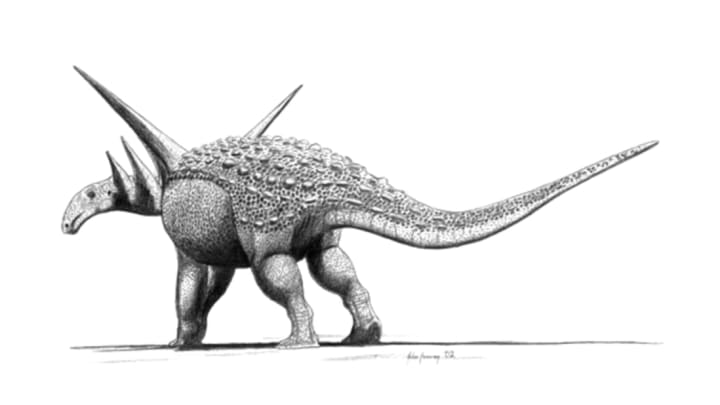Proving that herbivorous animals can look just as threatening as any flesh-eater is Sauropelta, a North American dinosaur with some major-league body armor.
1. It Hails from a Very Successful Dino Family Called “The Nodosaurs”
These tank-like creatures first evolved during the late Jurassic period and stuck around until roughly 67 million years ago.
2. Sauropelta’s Terrifying Spikes Might’ve Helped it Deceive Predators
Carnivores beware! When viewed from the front, the rows of upward-pointing spikes on Sauropelta’s backside likely made the animal look much larger than it actually was. Sometimes, sheer intimidation can be an awfully effective weapon.
3. Sauropelta Had to Wait Several Decades Before Getting a Name
Despite having been discovered during the Great Depression, this animal wouldn’t receive its official scientific name until 1970.
4. Sauropelta Probably Dined Selectively
Nodosaurs are known for sporting relatively narrow snouts, yet another group of heavily-armored dinos—the Ankylosauridae—had wide, blunt muzzles instead. This has led some experts to deduce that Sauropelta and company fed more discriminately than their ankylosaurid counterparts (whose mouths appear built to shovel in food haphazardly).
5. Nodosaur Footprints Tend to Get Mixed Up with Some Very Different Dinosaurs’
Their fossilized tracks bear a close resemblance to those of “horn-faced” (“ceratopsian”) dinos like Triceratops. Naturally, this has caused some confusion over the years, but a few key differences may be spotted if you know what to look for.
6. One of Sauropelta’s Bigger Relatives Was Almost Called “Denversaurus”
Colorado’s capital once came heartbreakingly close to getting a cool dinosaur named after it. In 1988, paleontologist Robert Bakker announced the discovery of an allegedly new nodosaur genus he dubbed “Denversaurus.” But, alas, the name’s since been terminated. Current consensus holds that Bakker’s critter was really just a species of Edmontosaurus. Sorry, Denver.
7. Sauropelta May Have Gotten Pretty Cheeky
Though modern reptiles lack cheeks, some experts have argued that nodosaurs and some other groups of herbivorous dinos had them anyway; a claim that’s been met with controversy over the years.
8. Sauropelta had More Vertebrae in its Tail Than You Do in Your Entire Body
If you tallied up every single bone in a normal human spinal column, you’d end up counting 33 individual vertebrae. Sauropelta’s tail alone, meanwhile, had at least 40!
9. The American Museum of Natural History Features a Very Special Sauropelta Display
One of the best-preserved nodosaur skeletons ever found —a partial Sauropelta specimen—is currently on display in this Manhattan museum. Dinosaur fans living near the greater NYC area are encouraged to drop what they’re doing and go check it out.
10. Some Nodosaurs Seemed to Bloat (and Possibly Explode) After Death
The bottom of the sea seems like no place for a stout, heavily-armored dinosaur to wind up. Yet, nevertheless, ankylosaur and nodosaur fossils are occasionally unearthed in the marine sediments left by ancient oceans.
How’d they get that far offshore? Here’s one hypothesis which gives a whole new meaning to the term “breaking wind.” When an animal starts to decompose, internal gasses begin building up, causing the body to swell. So, let’s say an unlucky nodosaur decides to go wading near some prehistoric beach and suddenly drops dead. The animal’s corpse then starts bloating until it physically floats away.
But all that gas has to go somewhere. Like an over-pumped balloon, the mounting pressure eventually rips through our dino’s skin in a fleshy explosion. Afterwards, its carcass finally sinks.
For you visual learners out there, here’s some graphic footage of a dead sperm whale suddenly erupting thanks to this process:
